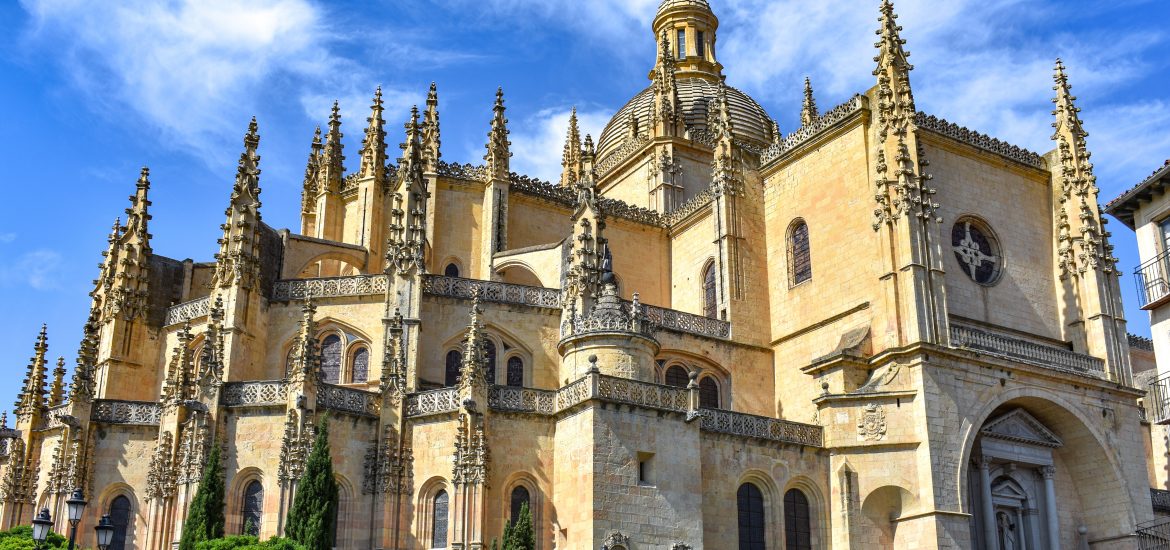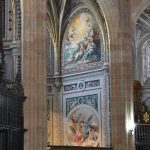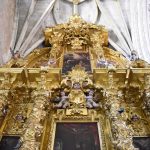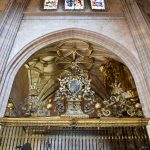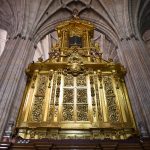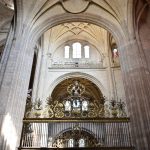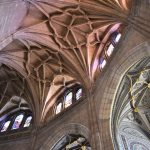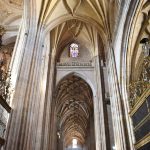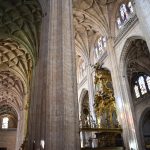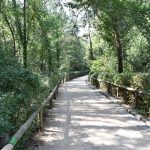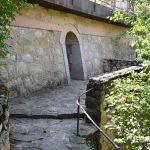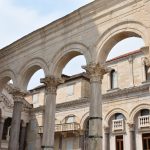As the UNESCO comments:
The Roman aqueduct of Segovia, probably built c. A.D. 50, is remarkably well preserved. This impressive construction, with its two tiers of arches, forms part of the setting of the magnificent historic city of Segovia. Other important monuments include the Alcázar, begun around the 11th century, and the 16th-century Gothic cathedral.
塞哥维亚古城及其输水道: 塞哥维亚古罗马输水道,大概建于公元50年前后,迄今保存完好,令人称奇。这一建筑以双层拱洞为特点,给人留下深刻的印象,成为塞哥维亚历史古城一道亮丽的风景线。在这里,人们还可以参观阿尔卡萨尔教堂,它始建于公元11世纪,完成于16世纪,是著名的哥特式大教堂。
The Old Town of Segovia is located in the centre of Spain, in the Autonomous Community of Castile and León. The centre is crowded together on the rocky bluff delineated by the confluence of the Eresma and Clamores rivers.
Segovia is symbolic of a complex, historical reality. Its neighbourhoods, streets, and houses are laid out in accordance with a social structure in which hierarchy was organized and dominated by belonging to one of the different cultural communities. Moors, Christians, and Jews coexisted for a long period of time in the medieval city and worked together during the 16th century manufacturing boom. The evidence of this cultural process can be seen in the large number of outstanding monuments in the city, among which, the Roman Aqueduct stands out. Other important monuments can be found in the property: the Alcázar, begun around the 11th century; several Romanesque churches; noble palaces from 15th and 16th centuries; the 16th-century Gothic cathedral, the last to be built in Spain in this style; and the Segovia Mint, the oldest industrial building still existing in Spain.


In this post I’m gonna focus on writing about the cathedral and the Alcázar. If you haven’t read my first post about Segovia, I can give you a brief introduction of it here. I was focusing in my previous post on the Roman Aqueduct as well as the guided tour called “World Heritage”. What’s more, based on my own experience, I also provided some practical information such as how to plan your trip in advance, how to arrive at the Segovia city center from Madrid and how to consult or what information you can get from the Tourism Office to make the most of your time there. If you wanna know more about the Aqueduct of Segovia, the “World Heritage Tour” or how to explore the historic old town of Segovia, for example, exploring the streets, squares or monuments, please click here to read my previous post “The Old Town of Segovia (1/2) – the Roman Aqueduct and a Guided Tour“.
As I mentioned in my previous post, I suggest you plan at least one whole day here in Segovia because there are indeed many things to see. For example, the Roman Aqueduct, the Cathedral of Segovia, the Alcázar, the main street (Calle Real), the main square (Plaza Major), the Jewish Quarter and the Canonical Neighborhood are the must-see places. I visited the aqueduct, the squares, streets and the buildings around them plus the inside of the Alcázar in the guided tour and explored the inside of the cathedral by myself. I wish I had more time so I could visit the Jewish Quarter Visitor Center as well. Anyway, I made a small detour to the hiking trail close to the Jewish Cemetery for a better view of the city and it was worth the time and effort. Now, I’ll divide the following post into 3 parts, introducing in detail the Cathedral of Segovia, the Alcázar and the hiking trail close to the Jewish Cemetery respectively. If you have any questions please don’t hesitate to contact me.
1. The Cathedral of Segovia




1.1 Opening hours:
Visit to the cathedral:
- November – March: 9:00 – 19:00
- April – October: 9:30 – 21:30
Mass:
- Monday – Saturday: 10:00
- Sundays and holidays: 11:00 and 12:30
Confession: 10:00 – 11:30
Visit to the Bell Tower:
- November – March: 10:30, 12:30 and 16:30
- April – October: 10:30, 12:30, 16:30 and 19:00
1.2 Ticket prices:
Ticket to visit the cathedral:
- General ticket: 3 €
- Reduced price: 2.5 € (groups with more than 20 people, disabled and retired people)
- Free entrance: Children under 10 years old, Segovians and Sundays from 9:30 to 13:30 (only to the cathedral, not including the museum and the cloister)
Ticket to the Bell Tower: 5 €
Ticket to the Bell Tower + the cathedral: 7 €
Please note that:
- tourist visits are not allowed during Masses (according to what I’ve read, I think the masses are only held in the Chapel of the Holy Sacrament, so I guess you can still visit the rest of the cathedral)
- you can only visit the Bell Tower at specific time slots (at most four times a day), so if you plan to do it you have to plan your visit in advance. I regret it so much that I went there after 15:00 and my bus would leave at 17:00 so I didn’t make it to the 16:30 visit. Such a pity!
- the last entrance to the cathedral is 30 mins before its closing time.
The information I provided above is for ensuring you a smooth and pleasant visit to the cathedral. Now, let’s start exploring this Late Gothic style masterpiece.
First of all, let’s take a look at the historical side of it. The original Cathedral of Segovia, located opposite the Alcázar was called Santa Maria and was of Romanesque style. However, it was destroyed in 1521 during the Communities War. This destruction led to the proposal of Charles V to build a new cathedral, which was to be the “pride and glory of all the city”, reflecting the religious faith of all the Segovians. The construction began in 1525 and with considerable physical effort and economic support from the Segovia people, the cathedral was eventually consecrated on 16th July 1768 by bishop don Juan José Martínez Escalzo. This project was under the direction of the architects of the family Gil de Hontañon and is defined by style and chronology as the last Gothic church in Spain. Now let’s take a look at the exterior of this masterpiece.
The cathedral is said to be the favorite meeting place for the storks in the evening and if you are lucky I believe you can see some on top of the pinnacles. The most eye-catching parts of the cathedral are probably the bell tower and the apse adjacent to the old Jewish quarter. The bell tower is especially impressive because of its height and if you plan your trip in advance and climb to the top of it, you will have a wonderful view of the whole city. The tower was inhabited by the toller until the mid 20th century. The apse that you can see from the Jewish Quarter or from the main square is also really marvelous, in particular because of its limestone buttresses and the pinnacles around the cupola. There are 3 entrances to the cathedral (nowadays only one is in use), that is to say the main entrance on the west side called Puerta del Perdón, the entrance on the south called Puerta de San Geroteo (named after the first bishop of Segovia), and the entrance on the north called Puerta de San Frutos (in honor of the patron saint of the city). Now let’s enter from the North Entrance and explore the interior of the cathedral.
The inside of the cathedral consists of three naves with the transept and a semicircular apse in the sanctuary made up of a chancel and an ambulatory which is surrounded by seven chapels. What’s noteworthy in the cathedral are the stained-glass windows, the chapels, the altarpieces, the choir stalls, the Baroque organs, the cloister, the cathedral museum and the cathedral archive (please note that the archive is private and not accessible to visitors). Now I’ll show you what you can expect in the Cathedral of Segovia.
I strongly recommend you taking a brochure at the ticket office so you can see on the map all the sites such as chapels, cloister, choir, chancel and so on from number 1 to number 27. Please note that number 18, the sacristy and number 19, the archives are not open to visitors.
1.3 What to visit in the cathedral
1.3.1 The chapels



The 18 chapels surrounding the ambulatory and along the side naves are worth visiting because of their important sculptures and paintings. What’s especially worth visiting is the Chapel of the Holy Sacrament, with the main altarpiece designed by José Benito de Churriguera, and the side altarpiece of The Agony of Christ by sculptor Manuel de Pereira with ceramics by Daniel Zuloaga.
1.3.2 The Central Altar (No. 16)

The altarpiece of the chancel is dedicated to Our Lady of Peace and was donated to the city by Enrique IV.
1.3.3 The Retrochoir (No. 6)

Here you can see the neo-classic retrochoir with the urn containing the relics of Sant Frutos, the patron saint of Segovia. The central altarpiece is by Humbert Dumandre and the lateral pieces are by Ventura Rodríguez and Juan de la Torre. The sumptuously adorned framed wall mirrors were once used for lighting.
1.3.4 The choir (No. 15)


The 116 walnut choir stalls are from the original cathedral and the two large organs were constructed by Chavarría organ makers.
1.3.5 The cloister


The cloister was designed by Juan Guas in the 15th century and was transferred here piece by piece from the original cathedral. This is also the burial site of the architect Rodrigo Gil de Hontañón. From the two pictures above in this section, you can see the entrance to the cloister and the cloister. Please note that it is from here that you can enter the cathedral museum, which has paintings, sculptures, gold and silver works and so on. What’s the most noteworthy are the 17th century tapestries from Brussels and the beautiful Renaissance ceiling in the Chapter House, said to have been gilded with the first gold brought from America (Unfortunately photos are not allowed in the museum so I can’t show you how amazing they are…). Though the cathedral Archives is private and not accessible to the visitors, it’s interesting to know that it has a collection of documents dating back to the 12th century and stores the first book printed in Spain, “Sinodal de Aguilafuente”.
Having visited the cathedral, now I suggest you walk through the Canonical Neighborhood and stop in the garden for a moment in front of the Alcázar. This garden is closely connected to the current cathedral because as I mentioned above, here is where the old original Romanesque cathedral was situated before its destruction. What’s more, you can also see the statue by Aniceto Marinas, of the heroes in the Independence War. Now if you walk through the garden, you will probably see the drawbridge leading to the castle. Move yourself a little bit to the side of the bridge before you walk on it. Can you see a small tunnel under it (now it seems like a nest of the pigeons)? That’s where the aqueduct led the water to the castle. From here to the bottom of the well in the yard, it is most likely the last section of the Roman Aqueduct in Segovia. Now let’s see what we can expect from the inside of this magnificent and fairylike castle.

2. The Alcázar of Segovia




2.1 Opening hours:
- Winter (November – March): 10:00 – 18:00
- Summer (April – October): 10:00 – 20:00
Please note that:
- the last ticket sale and the last entrance to the castle or the tower are 30 mins before the closing time
- in October, Summer opening hours for weekends while Winter opening hours for weekdays.
2.2 Ticket prices:
Ticket to visit the castle:
- General ticket: 5.5 €
- Reduced price: 3.5 € (pre-booked groups, travel agencies, students, people over 65 years old and large family card holders)
- Residents in Segovia: 1 €
- Guided tour supplement (per person): 1 € (only in Spanish, and check in advance for availability)
- Audio guide: 3 €
- Guided tour for groups: 40 €
- Free entrance: Tuesdays (except bank holidays) from 14:00 – 16:00 for EU members.
Please note that:
- if you join the guided tour “World Heritage Route”organized by the Tourism Office of Segovia, you can enter the castle for free accompanied by your guide
- relevant documents are required if you wanna buy tickets with discounted prices
- guided tours are available in Spanish, English and French
- audio guides are available in Spanish, English, French, German, Japanese, Dutch, Italian, Portuguese, Polish, Russian, Chinese and Korean
- 5 € deposit is required when renting an audio guide
- on Tuesdays, the free entrance from 14:00 – 16:00 is only to the castle.
Ticket to visit the Tower de Juan II: 2.5 €
Please note that you need to climb the staircase with 152 steps.
2.2 Explore the Alcázar
The silhouette of the Alcázar is like an imaginary ship, ready to sail over the confluence of the Eresma and Clamores rivers. As you can see from the outside. the most amazing feature of this Alcázar is probably its towers. The main one that you can climb up to is the Tower of Juan II, which is 80 meters tall and decorated with sgraffito as well as another twelve smaller towers. If you have time, don’t miss the opportunity to climb up the spiral staircase and enjoy a wonderful view of not only the city, but also the woods that contain the Jewish Cemetery, the church of Vera Cruz, the medieval neighborhoods and the quarry where most of the limestone used in the construction of the cathedral was taken. The other tower which is worth noticing is the Tower of Alfonso X on the north side, but you probably can only see it when you’re in the yard where the well is located. This tower is where King Alfonso X the Wise studied the stars. You will hear more about him when you are in the Cord Room (Sala del Cordón).
Like many other great historical monuments, the Alcázar in Segovia has gone through its own ups and downs. Like the life of a human being, it had its own glorious and miserable moments. The earliest written record of the Alcázar dates back to the beginning of the 12th century while the drawbridge at the entrance and the fortress it was built on are probably from the Celtic era and Roman times respectively. Now let’s have a look at the milestones of the history of the Alcázar in Segovia (please note that the information that I provide below is based on the brochures “Alcázar de Segovia, let yourself be conquered”, “Segovia, World Heritage Site” and on the introduction to the Alcázar from the official website of Segovia Tourism).
- The Alcázar was converted into a royal residence in the 13th century.
- On 13th December 1474, Isabella I made her way from the Alcázar to be crowned Queen of Castile in the old Church of San Miguel on the Main Square of Segovia.
- The Alcázar obtained its final Gothic appearance in the 15th century thanks to Juan II and Enrique IV.
- The wedding of Philip II and Ana of Austria was also held here in the 15th century.
- It served as a state prison for almost two centuries before King Carlos III founded the Royal Artillery School in 1764, which is the world’s oldest active military academy.
- In 1862, a huge fire destroyed almost everything in the Alcázar and only few items survived. You will see a painting, which is among the few items, in the chapel. I was told by the guide that the Alcázar was restored according to the paintings of a Segovian painter who loved the castle and came here everyday to portray every detail of it. If the story is true, I guess without him or his paintings, we would never have seen such a spectacular masterpiece.
- Under the rule of Alfonso XII, the restoration work started in 1882.
Having learnt about the historical events of the Alcázar, I guess now you understand why I said it had gone through its own ups and downs. In the next section, I’m gonna show you how theses hundreds of years has changed the appearance of the Alcázar, reflected by the rooms of it. I suggest you take a brochure at the entrance called “Alcázar de Segovia, let yourself be conquered”, which contains a brief introduction to the castle, a map and a guide, which emphasizes on the highlights of each room that you are about to visit. Now let’s start our journey.
2.2.1 Sala del Palacio Viejo (the Old Palace Room)
This room features the Mudejar decorated walls as well as the Romanesque mullioned windows used to let in light to the original palace. What’s also worth noting here are the suits of armor. Do you know why some of the armor shoes are with sharp ends? They were used to stab the horses in the war and even during military trainings. Rather cruel, isn’t it?



2.2.2 Sala de la Chimenea (the Fireplace Room)
This room exhibits magnificent furniture of the 16th century.


2.2.3 Sala del Solio (the Throne Room)
Based on the name, the throne exhibited here was commissioned for the visit of Alfonso XIII and Queen Victoria Eugenia on occasion of the centenary of 2nd May 1808. What’s also worth noticing is the outstanding Mudejar ceiling from Urones de Castroponce, work of Xadel Alcalde.



2.2.4 Sala de la Galera (the Gallery Room)
Queen Catherine had this room built in 1412 and it was named after the old moulded ceiling resembling the hull of a ship upside down. The current ceiling we see is the result of recent restoration work.


2.2.5 Sala de las Piñas (the Pine Cone Room)
This room was built by the order of Enrique IV and was named after the 392 pine cone carvings on its moulded ceiling. (in some brochures, this room is called the pineapples room but I think the carvings on the ceiling look more like pine cones instead of pineapples)

2.2.6 Cámara Regia (the Royal Bedroom)

2.2.7 Sala de Reyes
This is probably the most famous and amazing room in the Alcázar because of the coffered ceiling and an original frieze with 52 polychrome seated statues representing the kings and queens from Asturias, Leon and Castilla, from Don Pelayo to Juana la Loca. The current layout was directed by Philip II.


2.2.8 Sala del Cordón (the Cord Room)
This room features a cord bordering the ceiling. Legend has it that the relief was ordered by Queen Violante as a lesson of humility for her husband Alfonso X the Wise, who once even claimed that God should have asked for his advice before creating the universe.
2.2.9 The Chapel
This chapel witnessed the wedding of Philip II and Ana of Austria. “The Epiphany” painted by Bartolomé Carduccio in 1600, one of the few items rescued from the huge fire in 1862, is now kept here.


2.2.10 Sala de Armas (the Armoury) & 2.2.11 Royal Artillery School Museum
If you like the military in general or weapons in particular, I’m sure you will be fascinated by these two exhibitions.


Having said and shown so much about the rooms, don’t forget to go out to the yard because it gives you a wonderful view over the gardens or even as far as the valleys, plains and mountains. If you don’t have to time to climb up the Tower of Juan II, I guess here will be your best spot for an overview of the surroundings. Oh, right, please also note the well in the yard because this is where the aqueduct officially ends (based on current archaeological evidence).



3. Hiking trails around the city of Segovia
After visiting the historic center of Segovia, the Roman Aqueduct, the Cathedral and the Alcázar, if you still have time, I would recommend you taking one or two hiking trails to have a better view of the city, or to make some nicer photos. Because for me the most attractive monuments in Segovia are the Roman Aqueduct, the cathedral and the Alcázar, I asked the Tourist Reception Center of Segovia where to go to have a better overview of them. The staff at the reception center recommended me in general 2 hiking trails. The first one is close to the Jewish Cemetery and the other one is from San Andrés Gate to Park/Garden No.2, to San Marcos Church and to the Mint. I only took the one around the Jewish Cemetery, again because I didn’t have enough time…
Please remember to take a city map from the Tourist Center and you will see clearly on it where the hiking trails are. If you can’t find the trails instantly, you can just ask the staff in the office the best spots to view the cathedral and the Alcázar, and I believe they will mark the routes for you.
Now I’ll focus a bit more on the route that I took. You can get on the trail by exiting the city from San Andrés Gate and afterwards please keep walking towards south along the trail. You will shortly go through a tunnel under the Cuesta de los Hoyos and you will be at the Jewish cemetery already. If you can’t read the map easily, then I suggest you simply follow the Jewish Cemetery signs which will finally lead you there. Once you arrive at the cemetery, there are basically two routes that you can choose. One is leading you towards the Alcázar while the other one is leading you towards the city center and the aqueduct. Please pay attention that the trail going towards the Alcázar has no exit and you will have to come back to the starting point to go back to the city. However, the other trail going to the city and the aqueduct does have an exit and you can go back to the city center from there. Please take a look at the pictures below to see what you can expect from the hiking trails.



Whether it’s because of the main street, the main square, the Aqueduct, the cathedral, the Alcázar, the Jewish Quarter, the Canonical Neighborhood, the valleys or the parks, the city of Segovia did leave me a deep impression. I am fascinated by its legends, history, culture, architecture, monuments and natural landscape. Had I more time, I would have explored it more and known it more. I regret so much that I didn’t manage to go to the bell tower of the cathedra, the Tower of Juan II, the Jewish Quarter Visitor Center, the other hiking trail and so on, but maybe it is these regrets that will bring me back to Segovia soon, sooner than I have expected.
